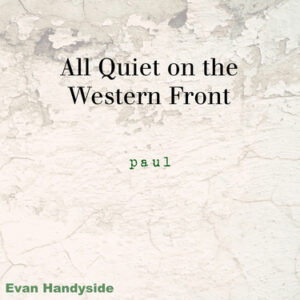All Quiet on the Western Front
This film has instantly become one of my all-time favorites. While based on a literary classic, All Quiet on the Western Front is not your “classic” war film. It has more in common with HBO’s Chernobyl, than 1917. There is no hero’s journey. The film immerses you into the gritty and hopeless nightmare (that was the German Western front) in WW1.
The movie is based on the book, Im Westen nichts Neues, by author Erich Maria Remarque, a German veteran of World War I. The book is a fictional accounting of the German soldiers’ extreme physical and mental trauma during the war. It’s an anti-war story that explores the total futility and desecration of warfare. An estimated 30 to 40-million copies of All Quiet on the Western Front have been sold since it was first published in 1929.
The book was so effective that Hitler had it discredited, burned, and banned. While author, Erich Remarque had used his literary success to move to America, his sister Elfriede Scholz, was viciously executed by the Nazis in 1943.
The latest film adaptation is beautifully shot in a wide, panoramic angle by director, Edward Berger. Amidst the violence, there are poignant scenes that brought me to tears. One in particular is the bomb crater scene — where the principle character Paul, fighting for survival, mortally stabs a French soldier. The Frenchman’s death is slow and excruciating. In a rush of humanity, Paul (Felix Kammerer) attempts to comfort the dying soldier. He becomes visibly shaken, and horrified that he extinguished the soul of this man; a husband, a father, a son.
The despair of trench warfare is expertly juxtaposed with scenes of elite opulence. Generals and politicians feasting — while soldiers starve in the cold mud.
The musical score is by German composer, Volker Bertelmann. He is often a co-composer with Dustin O’Halloran. Some of my favorite soundtracks have been from their union: Lion, Ammonite, and A Christmas Carol.
Like the film itself, Volker’s score for All Quiet on the Western Front should be in contention for awards season. It’s one of the most unique soundtracks you’ll ever hear, and it’s pivotal to the film. There’s an ominous, distorted 3 note motif — made with an early 1900’s harmonium. It’s a mechanized and dystopian sound that signals the industry of war; of which Paul and his comrades are replaceable cogs.
You might also like to play…
1917: Wayfaring Stranger | fingerstyle guitar + TAB
Gladiator: Now We Are Free | fingerstyle guitar + TAB
A Christmas Carol (Volker Bertelmann and Dustin O’halloran) | fingerstyle guitar + TAB
Spotify and streaming
You can find my arrangement of Paul on Spotify, Apple, Amazon Music, and all streaming services:
How to play Paul | fingerstyle guitar
The melancholy motif from All Quiet on the Western Front is titled Paul. I took this chord progression and expanded on it. Volker Bertelmann is in the post-classical space which is marked by minimalism. I tried to stay with that spirt and create a sparse fingerstyle arrangement. I drew a lot of inspiration from the bomb crater scene, as well as the music of Johann Johannsson.
The guitar tab for Paul is beautifully written across 3 pages. This piece is fairly easy to play and suitable for beginners.
Enjoy, the guitar tab is available below:
This piece is played straight through without repeats.
All Quiet on the Western Front: Paul | fingerstyle guitar
The tuning is one whole step down, except for the 6th string, which is tuned only a half step down. From Low to high: D# G C F A D.
If you refer to not play as low, you can tune every string down a 1/2 step, except for the Low E (6th) string. Your tuning will look like this, from low to high: E Ab Db Gb Bb Eb. Or, depending on you tuner, it will look like this: E G# C# F# A# D#. (Note: The Dexter Blood Theme is also in this same tuning.)
